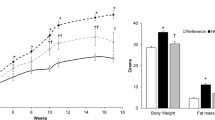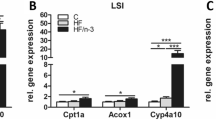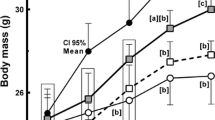Abstract
Differential effects of n-3 and n-6 polyunsaturated fatty acids (PUFAs) have been demonstrated on adipose tissue physiology. Facing to the widely recognized beneficial effects of n-3 PUFAs, the n-6 PUFA effects remain controversial. Thus, we further analyzed the linoleic acid (LA) influence on adipocyte functions. To this aim, we treated by LA supplementation at three distinct doses (1, 2.5, or 5 % of energy intake) rats with essential fatty acids deficiency (EFAD). PUFA composition was determined in blood and white adipose tissue (WAT), while lipolytic and lipogenic activities were measured in isolated adipocytes. EFAD rats exhibited reduced WAT mass and increased EFAD biomarkers. WAT mass was completely recovered after supplementation, irrespective of LA dose. However, neither body mass nor EFAD biomarkers returned to control with 1 % LA, while LA abundance doubled in adipocytes from rats supplemented with 5 % LA. Regarding lipolysis, 2.5 % LA normalized the EFAD-induced alterations. A trend to decrease the maximal stimulation of lipolysis was observed with 1 and 5 % LA. Regarding lipogenesis, the lower and higher LA doses increased basal activity and hampered insulin to further stimulate glucose incorporation into lipids whereas 2.5 % LA normalized the basal or insulin-stimulated levels. Our results show that dietary linoleate at 2.5 % restored anatomical, biochemical, and functional disturbances induced by EFAD. At higher dose, LA tended to reduce triacylglycerol breakdown, to increase triacylglycerol assembly, and to provoke insulin resistance. Therefore, LA influence on adipocyte functions does not appear to follow a typical dose–response relationship, adding further complexity to the definition of its dietary requirement.








Similar content being viewed by others
References
Ailhaud G, Guesnet P, Cunnane SC (2008) An emerging risk factor for obesity: does disequilibrium of polyunsaturated fatty acid metabolism contribute to excessive adipose tissue development? Br J Nutr 100:461–470
Ailhaud G, Massiera F, Weill P, Legrand P, Alessandri JM, Guesnet P (2006) Temporal changes in dietary fats: role of n-6 polyunsaturated fatty acids in excessive adipose tissue development and relationship to obesity. Prog Lipid Res 45:203–236
Alvheim AR, Malde MK, Osei-Hyiaman D, Hong Lin Y, Pawlosky RJ, Madsen L, Kristiansen K, Frøyland L, Hibbeln JR (2012) Dietary linoleic acid elevates endogenous 2-AG and anandamide and induces obesity. Obesity (Silver Spring) 20:1984–1994
Atgié C, Sauvant P, Ambid L, Carpéné C (2009) Possible mechanisms of weight loss of Siberian hamsters (Phodopus sungorus sungorus) exposed to short photoperiod. J Physiol Biochem 65:377–386
Berdanier CD, Baltzell JK (1986) Comparative studies of the responses of two strains of rats to an essential fatty acid deficient diet. Comp Biochem Physiol A Comp Physiol 85:725–727
Carpéné C, Rebourcet MC, Guichard C, Lafontan M, Lavau M (1990) Increased alpha 2-adrenergic binding sites and antilipolytic effect in adipocytes from genetically obese rats. J Lipid Res 31:811–819
Cicero AFG, Reggi A, Parini A, Borghi C (2012) Application of polyunsaturated fatty acids in internal medicine: beyond the established cardiovascular effects. Arch Med Sci 8:784–793
Clarke SD (2001) Nonalcoholic steatosis and steatohepatitis. I. Molecular mechanism for polyunsaturated fatty acid regulation of gene transcription. Am J Physiol Gastrointest Liver Physiol 281:G865–G869
Cohen-Luria R, Sigler L, Rimon G (1989) Biphasic effect of sodium fluoride and guanyl nucleotides on binding to prostaglandin E2 receptors in rat epididymal adipocyte membranes. Cell Signal 1:561–568
Dodge JT, Phillips GB (1967) Composition of phospholipids and of phospholipids fatty acids and aldehydes in human red cells. J Lipid Res 8:667–675
Duffaut C, Bour S, Prévot D, Marti L, Testar X, Zorzano A, Carpéné C (2006) Prolonged treatment with the β3-adrenergic agonist CL 316243 induces adipose tissue remodeling in rat but not in guinea pig: 2) modulation of glucose uptake and monoamine oxidase activity. J Physiol Biochem 62:101–112
Eder E, Wacker M, Lutz U, Nair J, Fang X, Bartsch H, Beland FA, Schlatter J, Lutz WK (2006) Oxidative stress related DNA adducts in the liver of female rats fed with sunflower-, rapeseed-, olive- or coconut oil supplemented diets. Chem Biol Interact 159:81–89
Fernández-Quintela A, Churruca I, Portillo MP (2007) The role of dietary fat in adipose tissue metabolism. Public Health Nutr 10:1126–1131
Ferrand C, Redonnet A, Prévot D, Carpéné C, Atgié C (2006) Prolonged treatment with the β3-adrenergic agonist CL 316243 induces adipose tissue remodeling in rat but not in guinea pig: 1) fat store depletion and desensitization of β-adrenergic responses. J Physiol Biochem 62:89–100
Folch J, Lees M, Sloane Stanley GH (1957) A simple method for the isolation and purification of total lipids from animal tissues. J Biol Chem 226:497–509
Gao Z, Zhang X, Zuberi A, Hwang D, Quon MJ, Lefevre M, Ye J (2004) Inhibition of insulin sensitivity by free fatty acids requires activation of multiple serine kinases in 3T3-L1 adipocytes. Mol Endocrinol 18:2024–2034
Garcia J, Ghisolfi J, Lapalu-Traon C, Periquet B, Olives JP, Boyer MJ, Thouvenot JP (1986) Screening for essential fatty acid deficiency in the infant. Ann Biol Clin 44:380–383
Gerber M (2009) Background review paper on total fat, fatty acid intake and cancers. Ann Nutr Metab 55:140–161
Gómez Candela C, Bermejo López LM, Loria Kohen V (2011) Importance of a balanced omega 6/omega 3 ratio for the maintenance of health: nutritional recommendations. Nutr Hosp 26:323–329
Gomez-Zorita S, Tréguer K, Mercader J, Carpéné C (2013) Resveratrol directly affects in vitro lipolysis and glucose transport in human fat cells. J Physiol Biochem 69:585–593
Hagenfeldt L (1966) A gas-chromatographic method for the determination of individual free fatty acids in plasma. Clin Chim Acta 13:266–268
Harant I, Carpéné C, Garcia J, Thouvenot JP, Ghisolfi J (1990) Correction by dietary linoleic acid of rat adipocyte metabolic disorders in essential fatty acid deficiency. Food Addit Contam 7:S134–S137
Harant I, Ghisolfi J, Couvaras O, Garcia J, Vaysse P, Thouvenot JP (1990) Fatty acid composition of adipocyte membrane phospholipids and stored triglycerides in infants receiving total parenteral nutrition. J Parenter Enteral Nutr 14:42–46
Hellwig B, Brown FM, Schürmann A, Shanahan MF, Joost HG (1992) Localization of the binding domain of the inhibitory ligand forskolin in the glucose transporter GLUT-4 by photolabeling, proteolytic cleavage and a site-specific antiserum. Biochim Biophys Acta 1111:178–184
Huang YS, Mitchell J, Jenkins K, Manku MS, Horrobin DF (1984) Effect of dietary depletion and repletion of linoleic acid on renal fatty acid composition and urinary prostaglandin excretion. Prostaglandins Leukot Med 15:223–228
Iritani N, Ikeda Y, Fukuda H (1984) Physiological impairment in linoleic acid deficiency of rats and the effect of n-3 polyunsaturated fatty acids. J Nutr Sci Vitaminol (Tokyo) 30:179–185
Juaneda P, Rocquelin G (1985) Rapid and convenient separation of phospholipids and non-phosphorus lipids from rat heart using silica cartridges. Lipids 20:40–41
Kirby A, Woodward A, Jackson S, Wang Y, Crawford MA (2010) The association of fatty acid deficiency symptoms (FADS) with actual essential fatty acid status in cheek cells. Prostaglandins Leukot Essent Fatty Acids 83:1–8
Kouba M, Mourot J (1998) Effect of a high linoleic acid diet on delta 9-desaturase activity, lipogenesis and lipid composition of pig subcutaneous adipose tissue. Reprod Nutr Dev 38:31–37
Le HD, Fallon EM, Kalish BT, de Meijer VE, Meisel JA, Gura KM, Nose V, Pan AH, Bistrian BR, Puder M (2013) The effect of varying ratios of docosahexaenoic acid and arachidonic acid in the prevention and reversal of biochemical essential fatty acid deficiency in a murine model. Metabolism 62:499–508
Lin YH, Salem N (2007) Whole body distribution of deuterated linoleic and alpha-linolenic acids and their metabolites in the rat. J Lipid Res 48:2709–2724
Makrides M, Smithers LG, Gibson RA (2010) Role of long-chain polyunsaturated fatty acids in neurodevelopment and growth. Nestlé Nutr Workshop Ser Pediatr Program 65:123–136
Massiera F, Saint-Marc P, Seydoux J, Murata T, Kobayashi T, Narumiya S, Guesnet P, Amri EZ, Negrel R, Ailhaud G (2003) Arachidonic acid and prostacyclin signaling promote adipose tissue development: a human health concern? J Lipid Res 44:271–279
Mercader J, Wanecq E, Chen J, Carpéné C (2011) Isopropylnorsynephrine is a stronger lipolytic agent in human adipocytes than synephrine and other amines present in Citrus aurantium. J Physiol Biochem 67:443–452
Moody AJ, Stan MA, Stan M, Gliemann J (1974) A simple free fat cell bioassay for insulin. Horm Metab Res 6:12–16
Muhlhausler BS, Ailhaud GP (2013) Omega-6 polyunsaturated fatty acids and the early origins of obesity. Curr Opin Endocrinol Diabetes Obes 20:56–61
Pérez-Matute P, Martinez JA, Marti A, Moreno-Aliaga MJ (2007) Linoleic acid decreases leptin and adiponectin secretion from primary rat adipocytes in the presence of insulin. Lipids 42:913–920
Pickova J (2009) Importance of knowledge on lipid composition of foods to support development towards consumption of higher levels of n-3 fatty acids via freshwater fish. Physiol Res 58(Suppl 1):S39–S45
Pinel A, Morio-Liondore B, Capel F (2014) Omega 3 fatty acids modulate metabolism of insulin-sensitive tissues: implication for the prevention of type 2 diabetes. J Physiol Biochem. doi:10.1007/s13105-013-0303-2
Prince MJ, Deeg MA (1997) Do n-3 fatty acids improve glucose tolerance and lipemia in diabetics? Curr Opin Lipidol 8:7–11
Schlemmer CK, Coetzer H, Claassen N, Kruger MC (1999) Oestrogen and essential fatty acid supplementation corrects bone loss due to ovariectomy in the female Sprague Dawley rat. Prostaglandins Leukot Essent Fatty Acids 61:381–390
Simopoulos AP (1994) Is insulin resistance influenced by dietary linoleic acid and trans fatty acids? Free Radic Biol Med 17:367–372
Simopoulos AP (2002) The importance of the ratio of omega-6/omega-3 essential fatty acids. Biomed Pharmacother 56:365–379
Simopoulos AP (2008) The importance of the omega-6/omega-3 fatty acid ratio in cardiovascular disease and other chronic diseases. Exp Biol Med (Maywood) 233:674–688
Soderhjelm L, Weise HF, Holman RT (1970) The role of polyunsaturated fatty acid in human nutrition and metabolism. Prog Chem Fats Lipids 9:555–585
Taouis M, Dagou C, Ster C, Durand G, Pinault M, Delarue J (2002) N-3 polyunsaturated fatty acids prevent the defect of insulin receptor signaling in muscle. Am J Physiol Endocrinol Metab 282:E664–E671
Willett WC (2007) The role of dietary n-6 fatty acids in the prevention of cardiovascular disease. J Cardiovasc Med (Hagerstown) 8:S42–S45
Wolf G (1996) Adipocyte differentiation is regulated by a prostaglandin liganded to the nuclear peroxisome proliferator-activated receptor. Nutr Rev 54:290–292
Yamanaka WK, Clemans GW, Hutchinson ML (1980) Essential fatty acids deficiency in humans. Prog Lipid Res 19:187–215
Acknowledgement
The authors express gratitude to Brigitte Periquet (Univ. Paul Sabatier, Toulouse, France) for her knowledge on adipocyte biology and dietary fatty acids, and to the staff of Biochemical analyses of Rangueil Hospital (Toulouse, France) for facilitating access to their devices.
Author information
Authors and Affiliations
Corresponding author
Rights and permissions
About this article
Cite this article
Harant-Farrugia, I., Garcia, J., Iglesias-Osma, MC. et al. Is there an optimal dose for dietary linoleic acid? Lessons from essential fatty acid deficiency supplementation and adipocyte functions in rats. J Physiol Biochem 70, 615–627 (2014). https://doi.org/10.1007/s13105-014-0315-6
Received:
Accepted:
Published:
Issue Date:
DOI: https://doi.org/10.1007/s13105-014-0315-6




